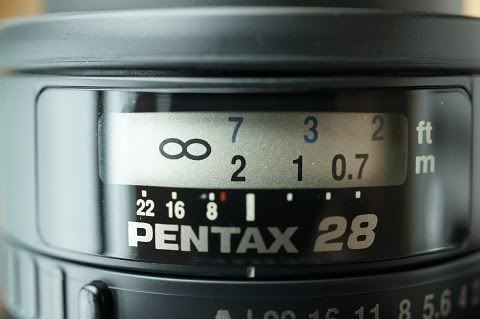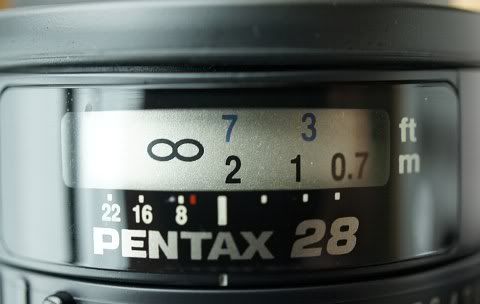Before going on, there is something to note about the Live View function (called "LV" thereafter) of those Pentax DSLRs, the aperture in the LV is controlled automatically by the camera body, in doubled f-stops per step from wide opened, according to the brightness level as metered, but NOT according to the set Av by the user nor by the camera in Program mode. Just say for example that a F1.4 Pentax prime is mounted onto the K-5, the stepping is from wide opened and then to f/2.8 and then to f5.6 and then to f/11, as brightness rises. This is different from other ILDC cameras and systems like the Sony NEX, which always stopped down to the exact set Av no matter how.
So, here we go, the following are the detailed procedures which I have designed and recommended. Read in full and strictly following these for the best results:-
1. First of all, we need to find an ideal AF target. Find something that is flat in surface, with white background and dark but coarse *irregular* patterns, which shows the highest contrasts which are easily distinguishable, like this:-

I focused on the "Kleenex" words. On the other hands, objects with coloured patterns are not recommended so as to avoid the effect of Chromatic Aberration of a lens that might exist, e.g., red colour would front focus more for some lenses.
2. Mount the camera body with the lens you want to calibrate/focus adjust on a sturdy tripod. Put it in the environment that you want it to focus correctly, e.g. at a particular subject distance and the light source you used. For the sake of standardised calibration basis at my side, I put the object at a distance at about 2 metres from the camera and used an artificial light source at about 5200K to simulate the natural daylight.
3. Turn on the Live View of the camera, do the Live View CDAF, observe the focus scale. Repeat the CDAF three times to see if focus arrives at the same position. If it is (as it usually does), note down the exact position of it, take the picture and then switch off LV. Check if the picture is correctly focused (it usually is).
N.B.1. If the lens does not have a focus scale, stick on some marks by yourself.
N.B.2. Do observe about the aperture chosen by the LV by watching through the lens from the front which is according to the brightness level as what I have briefed in the beginning. If you want the lens to be wide opened for the calibration, the lighting level is required to be turned down a bit so as to make it!
For illustration purpose, say for example, I achieved the LV CDAF focus with a perfectly sharp picture with the lens focused at this position, according to the focus scale of the lens:-

4. Go to the Custom Menu number 26 for "AF Fine Adjustment", select "Apply One" and you should see the "Unset" setting if the lens has not been calibrated before. Do note that the camera only supports Pentax lenses with an identifiable lens ID for the Pentax F series AF lenses or later.
5. Do the Phase Matching AF (PMAF) and see if it is front or back focused in comparison to what the Live View AF has determined. Do the PMAF for several times until the AF motor doesn't turn anymore.
If it is front focused, like this, key in a negative (-ve) value for the focus adjust:-

Otherwise, if it is back focused, like this, key in a positive (+ve) value instead:-

6. Key in the compensation focus adjust values by trial and errors until the PMAF completely agrees with the LV CDAF, i.e, turn on the LV mode, did the AF and then switch back to PMAF and re-do the AF, the lens focus ring should NOT turn, anymore.
So, we did it. Below are the results for some of my Pentax AF primes. I've noted that all my zoom lenses (no matter DA or FA) do not require any focus adjust before they were accurate but fast primes would. This may be owing to the lack of a f/2.8 AF sensor in any Pentax DSLRs, including the K-5. Thus, focus adjust by individual lens is essential and crucial:-
| Lens | Focus Adjust Value as Measured | Conditions |
| FA 28/2.8 | -2 | 2m, 5200K, f/2.8 |
| DA 35/2.4 | 0 | 2m, 5200K, f/2.4 |
| FA 43/1.9 | +5 | 2m, 5200K, f/1.9 |
| DA 70/2.4 | -5 | 2m, 5200K, f/2.4 |
| FA 85/1.4 | 0 | 2m, 5200K, f/2.8 |
| DFA 100/2.8 | 0 | 2m, 5200K, f/2.8 |
Good luck and happy measurebation! I hope that you would get razor sharp images with your Pentax primes (which are mostly capable of when focused correctly) after calibration with my above method! :-D One final reminder: Forget about all those "45 degree" inclined chart methods, which is not going to help you to do the job but would just create more confusions! Believe me.. The Live View will tell you the truth, really! Try it out by yourself! :-)
Related:-
K-5 and K-r Debug Mode Unleashed, Finally!
K-x Debug Mode Tutorial - AF Adjustment
Finally, I am Done! :-D